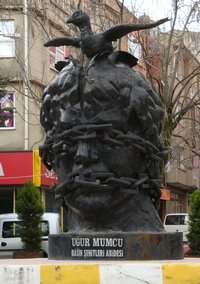Thracian transit point Population: 200,000
Old name: Cenopurio (Roman)
Heading out of İstanbul, it takes a good three-quarters of an hour to bypass the sprawl of the metropolis, where ugly new housing developments call to mind the dormitory settlements ringing the old Soviet cities. Not long afterwards, you reach Çorlu, an industrial city that was presumably a great deal more beautiful in the days when it was Cenopurio, of which nothing seems to remain, bar one wretched capital perched on the steps of the Atatürk Cultural Centre.
Around town
More mysterious is the complete disappearance of the külliye (mosque complex) designed by Sinan and bestowed on the town by Süleyman the Magnificent. Instead, the mosque that bears the sultan’s name today is the small Süleymaniye Cami, a work of the far less well-known mimar (architect), Kasım, dating back to 1521.
As if it wasn’t enough to have misplaced the remains of a Roman town and a Sinan mosque, Çorlu also seems to have shed a lovely old imperial mansion in which letter-writer extraordinaire Lady Mary Wortley Montagu stayed as she passed through on her way to İstanbul in 1717, accompanied by a string of 35 carriages. The rooms reserved for the women were, she wrote, “in the midst of thick groves of trees, made fresh by fountains,” which is not what she would write were she to visit again today.
In Gaziler Parkı beyond the meydan (square), old men sip tea in the sun beside what was once a fine old belediye (municipality) building. Past that you come to perhaps the oldest surviving building in town, the Fatih Cami, which dates to 1453. The new minaret added to what was once a simple rectangular hall is hardly an improvement but the crumbling old fountain and collection of Ottoman headstones in the grounds are as picturesque as Çorlu gets.

A little farther down the road you come to the new Uğur Mumcu Parkı, laid out in memory of the campaigning Cumhuriyet journalist who was killed by a car bomb in 1993.
The Yeni Cami, near the slight remains of Çorlu Kalesi (Castle) and the market-place, was converted from a synagogue with the addition of a minaret n 1970. It retains its original wooden ceiling.
If you keep looking out to the right, beyond Çorlu you will glimpse the remains of three of Sinan’s gracefully arched bridges, now partially buried in the ground.
More obvious once you pass the endless industrial development are humps and bumps in the landscape, which prove to be round barrows, burial mounds dating back to around the fourth century B.C. For British travellers, they will be vaguely reminiscent of those dotting the Salisbury Plain, but in fact they belong to a series of tumuli that continue over the border into Bulgaria, proof as ever that political boundaries cut straight across those of culture. The finds from some of these mounds are on display in the museums in Edirne and Kirklareli.
Sleeping
Although Çorlu has two and three-star hotels aimed at business travellers, you’re probably better off visiting on a day trip out of İstanbul.
Transport info
There are frequent buses from İstanbul’s Esenler bus terminal to Çorlu. Local buses link it to nearby Lüleburgaz.
Tekirdağ-Çorlu airport is sometimes used as a back-up if for any reason planes are unable to land at İstanbul International Airport.
Once daily trains connect Çorlu with İstanbul and Uzunköprü via Lüleburgaz and Çatalca.
Day trip destinations
Marmara Ereğli
Silivri


